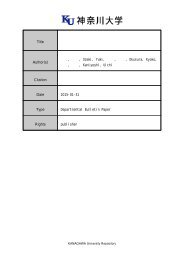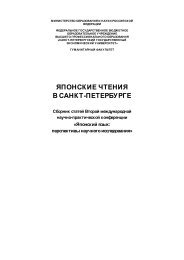to Learners with Special Educational Needs
e-textbook SEN
e-textbook SEN
You also want an ePaper? Increase the reach of your titles
YUMPU automatically turns print PDFs into web optimized ePapers that Google loves.
Pokrivčáková, S. et al. (2015). Teaching Foreign Languages <strong>to</strong> <strong>Learners</strong> <strong>with</strong> <strong>Special</strong> <strong>Educational</strong> <strong>Needs</strong>:<br />
e-textbook for foreign language teachers. Nitra: Constantine the Philosopher University. 128 p.<br />
ISBN 978-80-558-0941-0<br />
Parker (2006) states two ways <strong>to</strong> motivate learners <strong>to</strong> work on an assigned task and behave<br />
appropriately:<br />
1) Use of simple compliments like Great job!, Fantastic!, Couldn’t be better!, Great answer!.<br />
These simple compliments foster the ADHD learner’s motivation and simultaneously serve as a<br />
gateway <strong>to</strong> second-language acquisition and a positive attitude <strong>to</strong> second-language learning in<br />
the EFL classroom.<br />
2) School rewards, which can have different forms. These mainly depend on the learner, and<br />
what he or she likes. Some ideas for simple school rewards are as follows:<br />
Being teacher’s helper.<br />
Erasing chalkboard<br />
or whiteboard.<br />
Stickers.<br />
Writing on chalkboard.<br />
Positive note <strong>to</strong> parents.<br />
Being first in line.<br />
Sitting near a friend.<br />
Playing a game.<br />
Getting an award certificate.<br />
Collecting papers.<br />
Another option <strong>to</strong> modify education tasks <strong>to</strong> take the form of interesting games is the use of a<br />
“cover s<strong>to</strong>ry.” This works mainly <strong>with</strong> younger learners. For example, fill-in exercises can ask the<br />
child <strong>to</strong> play the role of a pirate who has <strong>to</strong> fill a chest <strong>with</strong> gold. Each correctly filled-in word or<br />
phrase (or whole exercise) is rewarded <strong>with</strong> a golden sticker, a star or a coin, which the child<br />
collects and sticks in<strong>to</strong> a paper chest.<br />
Carter (2011) claims that any activity can become a game when a time limit is introduced.<br />
The child should not compete <strong>with</strong> his/her classmates, but <strong>with</strong> the clock: for example, they can<br />
be asked <strong>to</strong> work out an exercise in a set time. This motivates the ADHD learner <strong>to</strong> focus on the<br />
task and ignore other external stimuli.<br />
Individualism<br />
This sub-principle draws on the fact that all children are individual human beings <strong>with</strong><br />
individual interests and opinions. ADHD children are no exception. Carter (ibid.) writes that the<br />
diagnosis of ADHD children is often perceived as more important than the individuality and<br />
personality beneath the surface of the disorder. This may result in underestimating and<br />
lowering their self-confidence. As Hvozdíková claims (2011, p. 463), “self-esteem is so low<br />
among these students that it may gradually grow in<strong>to</strong> serious difficulties in later teen years –<br />
in<strong>to</strong> a secondary disorder of self-esteem.” Therefore, it is always good <strong>to</strong> focus on the strengths<br />
of ADHD students and approach them individually.<br />
In the EFL classroom, interactive activities and activities <strong>with</strong> a lot of movement are best for<br />
ADHD learners. These are not only more fun, but make a virtue of ADHD learners’ energy and<br />
need <strong>to</strong> move. They are often very successful in these activities, demonstrate greater focus, and<br />
may “also find acknowledgement among their peers, gain confidence and inspire everyone <strong>with</strong><br />
their energy and enthusiasm” (Turketi, 2010, p. 4). Such activities might include:<br />
TPR – Total Physical Response<br />
Task-based learning<br />
Drama activities.<br />
Rules<br />
Rules can be defined as general standards for learners’ behaviour in all classroom situations<br />
(Wayne State University, n.d.). They are beneficial both for the teacher, as a <strong>to</strong>ol for effective<br />
classroom management, and the ADHD or ADD children, as they provide a safe environment for<br />
them <strong>to</strong> express their personalities. A teacher of ADHD learners must realize that these children<br />
require regular reminding of the rules. This is one reason why classroom rules:<br />
Should be clear, <strong>with</strong> no ambiguity <strong>to</strong> allow different interpretations. For example, “Class time<br />
is for class activities” rather than “No <strong>to</strong>ys or games in class.”<br />
84






